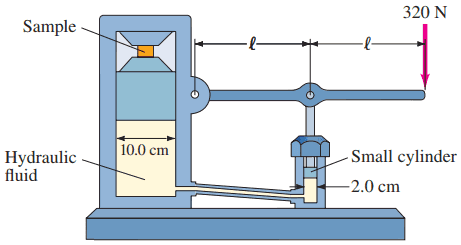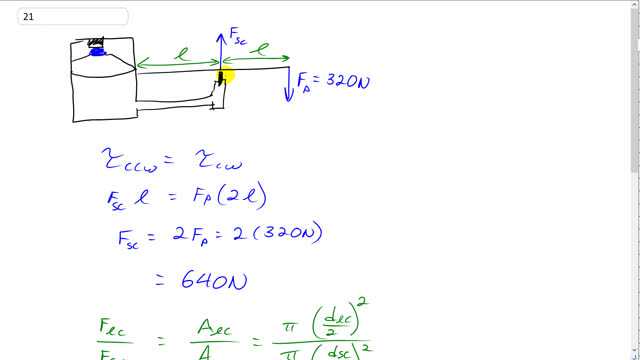
A hydraulic press for compacting powdered samples has a large cylinder which is 10.0 cm in diameter, and a small cylinder with a diameter of 2.0 cm (Fig. 10–51). A lever is attached to the small cylinder as shown. The sample, which is placed on the large cylinder, has an area of . What is the pressure on the sample if 320 N is applied to the lever?


In order to watch this solution you need to have a subscription.
This is Giancoli Answers with Mr. Dychko. If we assume that when we are pressing down with this force of 320 newtons at the end of the lever that the system isn't really moving so if it's just static and there's just some pressure being applied but the sample is not actually being squished then that means there's a force upwards on this lever that results in the same torque. So there is no net torque in other words. So the torque that's clockwise due to this applied force here is gonna equal the counter-clockwise torque due to the little cylinder pushing up on this lever here. So that means force on the small cylinder times its lever arm l equals the force applied by the person times its lever arm which is 2l and that gives us, after canceling the l's, the force exerted by this small cylinder which is also the force that's on this small cylinder— they are Newton's third law pairs— equals 2 times force exerted by the person which is 2 times 320 which is 640 newtons. So now that we know the force applied on the fluid in the small cylinder, we can find the mechanical advantage of this fluid system here, hydraulic system, and say that the force exerted by the large cylinder on this part here—the very bottom of its diaphragm here, this is the top of the fluid— this force divided by the force exerted on the small cylinder fluid equals the ratio of the areas so the area of this large cylinder here divided by the area of the small cylinder. So the area of this large cylinder is π times radius squared but we are given diameter's in this question so I'm gonna write radius as diameter divided by 2 so diameter of the large cylinder over 2 all squared and same idea for area of the small cylinder: π times diameter of the small cylinder divided by 2 squared. And then the π's cancel and so do this divide by 2 squared cancels as well and then multiply both sides by force on the small cylinder which we found before and we get force exerted by the large cylinder upwards which is 640 newtons times 10 centimeters squared divided by 2 centimeters squared— this is the diameter of the large cylinder and dividing it by the diameter of the small cylinder squaring each, not bothering with the unit conversion since all we care about is that the unit's cancel so they have to be the same, we get centimeters squared divided by centimeters squared canceling— 16000 newtons is the force applied upwards. So the pressure is the question though the pressure on the sample. So we know the force that's exerted on this sample now and divide that by the sample's area to get the pressure on it. So we have 16000 newtons divided by 4 centimeters squared and in this case, we do have to worry about the units and so we multiply this by 1 meter for every 100 centimeters squared and this works out to 4.0 times 10 to the 7 pascals is the pressure on this sample.